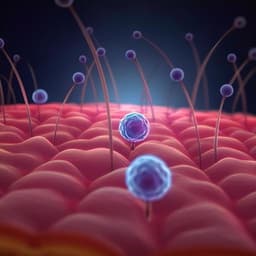
Engineering and Technology
Single and bundled carbon nanofibers as ultralightweight and flexible piezoresistive sensors
D. Sengupta, S. Chen, et al.
Explore the fascinating world of piezoresistive sensing elements with the innovative application of electrospun carbon nanofibers by Debarun Sengupta and colleagues. Discover how these ultralightweight sensors can transform stress detection and airflow measurement in cutting-edge technology.
Playback language: English
Introduction
Technological advancements in soft material processing and nanofabrication have spurred the development of flexible and wearable sensors. The demand for ultrathin, portable, and wearable sensors drives progress in soft and flexible material technologies. Traditional piezoelectric materials like PZT, barium titanate, and zinc oxide, while effective (especially PZT due to its high piezoelectric coefficient), face challenges: lead toxicity in PZT and brittleness hindering wearable applications. Soft piezoelectric polymers like PVDF and PVDF-TrFE offer alternatives due to low cost, flexibility, and biocompatibility, leading to extensive research in flexible energy harvesters and self-powered sensors. Electrospinning, a cost-effective and efficient method, enables the creation of large-area nanofiber mats and complex sensor structures, often surpassing traditional MEMS fabrication techniques.
However, piezoelectric nanofibers are limited to dynamic stimuli, making them unsuitable for static strain sensing. Piezoresistive sensors, utilizing the piezoresistive properties of flexible polymers, offer a newer approach. Researchers explore nanomaterial-polymer composites, including conductive carbon-based nanomaterials (graphene, CNTs, CNFs, CBs) and elastomeric substrates (ecoflex, PI, rubber, PDMS, PU). Many existing methods involve either fragile graphene structures or complex, multi-step fabrication processes. Electrospun CNF bundles represent a potentially cheaper and simpler alternative. While prior research has characterized the properties of graphitized electrospun PAN nanofibers and demonstrated the piezoresistive property of individual CNFs, their application in flexible sensors remains underexplored. The onset of piezoresistivity and the influence of pyrolyzation temperature are not fully understood. Single CNFs have shown modest gauge factors (1.96–2.55), but bundled CNFs potentially offer higher gauge factors due to changes in their conductance path under strain. This study aims to investigate the effect of pyrolyzation temperature on the microstructure, morphology, and electrical properties of electrospun PAN-based CNFs, using various characterization techniques (Raman, XPS, FESEM, TEM) to understand the onset of piezoresistivity at relatively low temperatures. It will demonstrate two modes of operation using single and bundled CNFs, creating ultralightweight and flexible strain sensors and a NEMS flow sensor.
Literature Review
The literature review section thoroughly examines previous research on piezoelectric and piezoresistive sensors. It highlights the limitations of traditional piezoelectric materials like PZT due to their brittleness and toxicity, contrasting them with the advantages of flexible piezoelectric polymers such as PVDF and its copolymers. The review also covers existing work on electrospinning as a fabrication technique for flexible sensors, emphasizing its cost-effectiveness and ability to produce complex sensor structures. A key focus is on the use of various carbon-based nanomaterials like graphene, CNTs, and CNFs in piezoresistive sensors, and their integration with different polymer substrates. The review notes the challenges associated with some existing fabrication methods, such as the fragility of free-standing graphene structures or the complexity of multi-step processes, leading to the motivation for exploring the use of electrospun CNF bundles as a simpler and more cost-effective alternative. Previous work on the mechanical and structural properties of CNFs, and the piezoresistive properties of individual CNFs are discussed. However, the lack of comprehensive studies on the use of CNF bundles in flexible sensor applications and the understanding of the effect of pyrolyzation temperature on piezoresistivity are identified as knowledge gaps addressed by this research.
Methodology
The study employed a multi-faceted methodology encompassing material synthesis, characterization, sensor fabrication, and performance evaluation. First, polyacrylonitrile (PAN) nanofibers were fabricated using electrospinning. A 9% (w/v) solution of PAN in DMF was prepared and electrospun using a rotating mandrel collector to achieve in situ alignment. The electrospinning parameters, including flow rate, voltage, and collector speed, were carefully controlled to optimize fiber morphology and alignment. The as-spun PAN nanofiber bundles and single nanofibers were then subjected to a two-step pyrolysis process. This involved a stabilization step at 245°C in air to form an oxide layer, followed by carbonization at various temperatures (500, 600, 700, 800, and 950°C) in a nitrogen atmosphere. The pyrolyzation temperature was a key parameter investigated to understand its effect on the material properties.
Detailed material characterization involved several techniques. FE-SEM was used to analyze the morphology and diameter of the nanofibers at different pyrolyzation temperatures. Raman spectroscopy determined the graphitic ordering and crystallite size, providing insights into the degree of graphitization. XPS analysis determined the compositional changes in the nanofibers (carbon, nitrogen, oxygen content) at different pyrolyzation stages, revealing the effect of the carbonization process on the chemical bonding and hybridization states. TEM imaging was employed to directly visualize the graphitic domains within the nanofibers. Electrical characterization involved measuring the sheet resistance of the CNF bundles at different pyrolyzation temperatures using a cascade probe station.
Two types of sensors were fabricated. For the bundled CNF strain sensor, the pyrolyzed CNF bundles were embedded in PDMS or attached to optically clear adhesive (OCA) films to create flexible and stretchable sensors. These sensors were characterized using quasi-static tensile strain testing (CNF-PDMS), static and dynamic bending tests (CNF-OCA), and long-press tests to evaluate their responsiveness to different types of strain stimuli. For the single CNF flow sensor, single CNFs were electrospun across micro-trenches on a silicon wafer. After pyrolysis, these sensors were tested in a subsonic wind tunnel, measuring the change in resistance with varying airflow velocities. A Wheatstone bridge circuit was used for data acquisition in many sensor tests, and a voltage divider circuit was used for the flow sensor. Data was acquired using a National Instruments data acquisition system (DAQ).
Key Findings
The characterization of electrospun PAN-based CNFs revealed a significant impact of pyrolyzation temperature on their morphology, structure, and electrical properties. FE-SEM showed a decrease in nanofiber diameter with increasing pyrolyzation temperature due to densification and weight loss from the release of oxygen and nitrogen. Raman spectroscopy indicated an increase in the size of graphitic crystallites (La) with increasing pyrolyzation temperature, signifying enhanced graphitization. XPS confirmed the increasing carbon content and decreasing nitrogen and oxygen content as the pyrolyzation temperature increased, highlighting the decomposition of carbon-nitrogen and carbon-oxygen bonds and the formation of carbon-carbon bonds. TEM imaging revealed the presence of layered graphitic domains in CNFs pyrolyzed at higher temperatures, corroborating the Raman findings.
Electrical characterization showed a significant decrease in the sheet resistance of CNF bundles with increasing pyrolyzation temperature, indicating an enhancement in conductivity due to the formation of graphitic domains. This aligns well with the Raman and XPS results. The hypothesis of conductive graphitic domain discontinuity was used to explain the piezoresistivity in single CNFs, attributing it to changes in electron tunneling resistance caused by strain-induced changes in the distance between graphitic domains. The bundled CNF strain sensors showed excellent flexibility and linearity in their response to strain. The CNF-PDMS sensor exhibited a linear response up to 50% tensile strain, with an average gauge factor of 11.14. This gauge factor is considerably higher than those reported for other nanomaterial-based piezoresistive sensors in literature. Static bending tests on the CNF-OCA sensor demonstrated a linear response to bending curvature, and dynamic tests showed that the sensor accurately replicated cyclic strain stimuli. The single CNF flow sensor successfully detected airflow velocities in the range of 5–35 m/s, exhibiting a change in voltage proportional to the airflow velocity. This work demonstrates that the piezoresistive effect observed is significant and can be used for various applications.
Discussion
The findings of this research significantly advance the understanding and application of CNFs in flexible and ultralightweight piezoresistive sensors. The detailed characterization of CNFs, revealing the relationship between pyrolyzation temperature and material properties, provides critical insights for optimizing the synthesis of these nanomaterials for sensor applications. The exceptionally high gauge factor of the bundled CNF strain sensor (11.14), surpassing those of other reported nanomaterial-based sensors, underlines the potential of CNFs as a highly sensitive sensing element. The successful demonstration of both strain and flow sensing applications using single and bundled CNFs validates the versatility and potential of CNFs for various sensing modalities. The conductive graphitic domain discontinuity model effectively explains the observed piezoresistive behavior, highlighting the importance of the microstructure and the tunneling effect in the electrical conductivity of CNFs. The results support the feasibility of using CNFs as a cost-effective alternative to other nanomaterials, particularly for flexible sensor applications where high sensitivity, flexibility, and lightweight are crucial. The findings contribute significantly to the field of flexible electronics and sensing technologies.
Conclusion
This study demonstrates the successful fabrication and characterization of highly sensitive, flexible, and ultralightweight piezoresistive sensors using electrospun carbon nanofibers (CNFs). The impact of pyrolyzation temperature on CNF properties was comprehensively investigated, optimizing sensor performance. The high gauge factor achieved by the bundled CNF strain sensor (11.14) and the successful demonstration of flow sensing with a single CNF sensor underscore the potential of CNFs for various applications in wearable electronics and NEMS. Future work could explore the integration of these sensors with advanced microelectronics for more complex sensor systems, further optimization of CNF synthesis parameters, and exploration of applications beyond strain and flow sensing.
Limitations
While this study demonstrates the significant potential of CNFs for piezoresistive sensing applications, some limitations exist. The long-term stability and durability of the fabricated sensors under various environmental conditions remain to be thoroughly investigated. The study focuses primarily on static and dynamic strain sensing and airflow sensing; further exploration is needed to determine the suitability of CNF-based sensors for other types of stimuli. The fabrication process may require further optimization to achieve higher reproducibility and scalability for mass production. A more in-depth investigation of the influence of different polymer substrates on sensor performance may also provide valuable insights.
Related Publications
Explore these studies to deepen your understanding of the subject.







